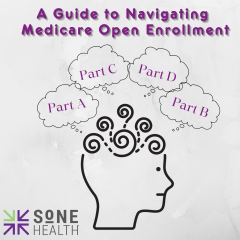 By: Bill McCarthy, Senior Vice President at May, Bonee & Clark Insurance (a full-service insurance brokerage agency)
By: Bill McCarthy, Senior Vice President at May, Bonee & Clark Insurance (a full-service insurance brokerage agency)
Are you approaching the age of 65, newly retired over age 65, or recently qualified for Medicare due to a disability? Congratulations, you’re about to embark on a new chapter in your healthcare journey. As a newly eligible Medicare beneficiary, you’ll soon have the opportunity to make important decisions during the Medicare Open Enrollment period. In this blog, we’ll walk you through the basics of Medicare and offer valuable insights to help you make informed choices during this crucial time.
Understanding the Basics
Medicare is a federal health insurance program primarily designed for individuals aged 65 and older. However, it also covers younger people with disabilities and those with certain medical conditions. It is divided into four parts:
- Part A: This covers hospital expenses and is typically provided at no cost to eligible individuals. You’re automatically enrolled if you’re receiving Social Security benefits.
- Part B: This covers doctor’s visits, outpatient care, and medical services. There is a monthly premium associated with Part B, and you can choose whether to enroll in it when you become eligible.
- Part C (Medicare Advantage): These are private health plans that combine the benefits of Parts A and B and often include prescription drug coverage. You have the option to choose a Medicare Advantage plan if it suits your needs.
- Part D: Part D plans provide prescription drug coverage, and you need to enroll in a separate plan to access this benefit.
Medicare Open Enrollment: What You Need to Know
Medicare Open Enrollment is an annual period that typically runs from October 15th to December 7th. During this time, you can enroll in a Medicare Advantage or Part D plan or change either of those plans if you are a current member. Whether you’re newly eligible or a current Medicare Advantage or Plan D member, it’s important to review your options and make informed choices. Here are some key things to consider:
- Review Your Current Coverage: Take a close look at your existing Medicare coverage, including your Part A, Part B, and any additional plans like Medicare Advantage or Part D. Evaluate how well your current coverage meets your healthcare needs.
- Consider Your Health Needs: Reflect on any changes in your health or medication needs. Different plans may provide better coverage for specific health conditions, so it’s essential to choose a plan that aligns with your current and future health requirements.
- Compare Plans: During Open Enrollment, you can switch between Original Medicare (Part A and Part B) and Medicare Advantage plans. Additionally, you can switch or enroll in Part D prescription drug plans. Use the Medicare Plan Finder tool on the official Medicare website to compare plans available in your area.
- Budget Wisely: Examine your budget and compare plan premiums, deductibles, and copayments. A lower premium plan might seem attractive, but it could result in higher out-of-pocket costs when you require healthcare services. Balance your budget with your healthcare needs.
- Network and Providers: Ensure that the healthcare providers, hospitals, and pharmacies you prefer are in-network with the plan you choose. Access to your preferred healthcare professionals is crucial for receiving quality care.
- Enrollment Process: Remember that you have a limited window to make changes during Open Enrollment. Ensure that you enroll or make any necessary changes before the deadline to avoid gaps in your coverage.
Tips for a Smooth Open Enrollment Experience
- Start Early: Don’t wait until the last minute to research and make decisions. Start early to give yourself enough time to evaluate your options thoroughly.
- Seek Assistance: If you find the process overwhelming, don’t hesitate to seek assistance from a Medicare counselor, insurance broker, or even a trusted family member or friend who has experience with Medicare.
- Keep Records: Keep records of your enrollment decisions, plan information, and any correspondence related to your Medicare coverage. This can be valuable in case of any disputes or issues.
Conclusion
Medicare Open Enrollment is a critical time for both newly eligible beneficiaries and existing Medicare recipients. It’s an opportunity to ensure that your healthcare coverage aligns with your current needs and budget. By understanding the basics of Medicare, reviewing your options, and following the tips outlined above, you can make informed choices that set you on the path to a healthy and secure healthcare future. Remember, the decisions you make during Open Enrollment can have a significant impact on your health and finances, so approach the process with care and consideration.
